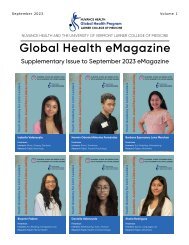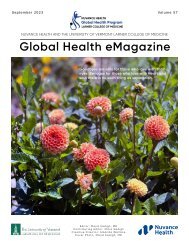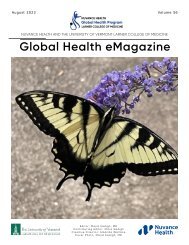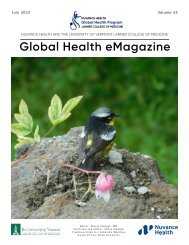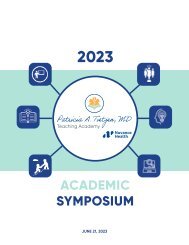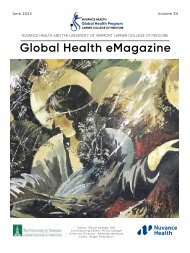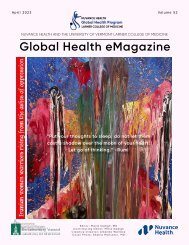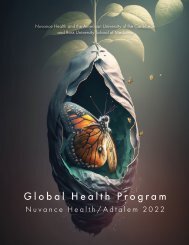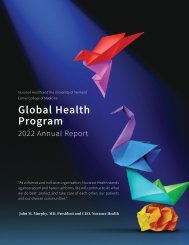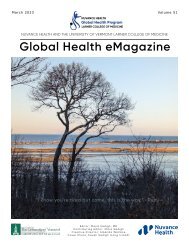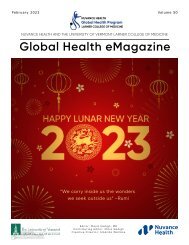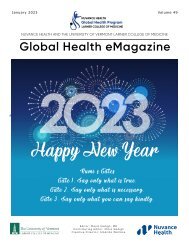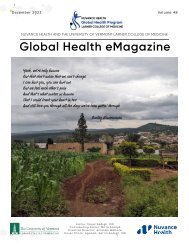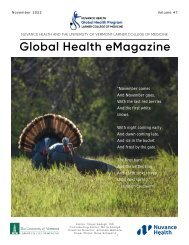eMagazine September 2022
You also want an ePaper? Increase the reach of your titles
YUMPU automatically turns print PDFs into web optimized ePapers that Google loves.
<strong>September</strong> <strong>2022</strong> Volume 45<br />
NUVANCE HEALTH<br />
Global Health Program<br />
LARNER COLLEGE OF MEDICINE<br />
NUVANCE HEALTH AND THE UNIVERSITY OF VERMONT LARNER COLLEGE OF MEDICINE<br />
Global Health <strong>eMagazine</strong><br />
Be a lamp, or a lifeboat,<br />
or a ladder. Walk out of<br />
your house like a shepherd.<br />
Rumi<br />
Editor; Majid Sadigh, MD<br />
Contributing Editor; Mitra Sadigh<br />
Creative Director; Amanda Wallace<br />
Cover Photo: Rose Schwartz
OUR PEOPLE,<br />
OUR MISSION<br />
Global Health<br />
<strong>eMagazine</strong><br />
<strong>September</strong> <strong>2022</strong><br />
Written by Swapnil Parve, MD<br />
Highlights<br />
Director of International Affairs UVMLCOM-Nuvance Health Global Health<br />
Program<br />
Global Health Electives in India<br />
Highlights<br />
Dr. Swapnil Parve, the Director of International Affairs of the Global Health Program<br />
is currently accompanying RUSM/AUC students on their global health elective at<br />
our partner institution Datta Meghe Institute of Medical Sciences (DU) in India.<br />
Spotlight<br />
Reflections<br />
Health Disparities Within Our<br />
Borders<br />
Nursing Division<br />
Among the Letters<br />
Our Beautiful Planet<br />
Art to Remember<br />
Who We Can Be<br />
Article of he Month<br />
Videos of the Month<br />
Global Health Family<br />
Calendar<br />
Photo News<br />
Resources<br />
From left: Dr. Syed Zahiruddin Quazi (Director, Research and Development, DMIMS-DU), Dr. Abhay<br />
Gaidhane (Dean, Jawaharlal Nehru Medical College, DMIMS-DU) and Dr. Swapnil Parve (Director of<br />
International Affairs, NVHGHP).<br />
RUSM and AUC students were given a warm welcome by the program coordinators<br />
and the leadership and were placed in comfortable and safe dorms within the<br />
campus. They started their rotations in the department of internal medicine with a<br />
structured curriculum and after two weeks have been shifted to the departments<br />
of their choices: surgery, OBGYN, and pediatrics.<br />
2
OUR PEOPLE,<br />
OUR MISSION<br />
Global Health<br />
<strong>eMagazine</strong><br />
<strong>September</strong> <strong>2022</strong><br />
Highlights<br />
Spotlight<br />
Reflections<br />
Left to right: Dr. Punit Fulzele, Dr. Syed Zahiruddin Quazi, Dr. Abhay Gaidhane, Dr. Wagha, Ashley<br />
Diaz, Danielle Azani, Nistha Acharya and Dr. Swapnil Parve.<br />
Health Disparities Within Our<br />
Borders<br />
Nursing Division<br />
Among the Letters<br />
Our Beautiful Planet<br />
Art to Remember<br />
Who We Can Be<br />
Article of he Month<br />
Videos of the Month<br />
Global Health Family<br />
Calendar<br />
Photo News<br />
Resources<br />
Left to right: Ashley Diaz, Nistha Acharya,<br />
and Danielle Azani on the floors of Acharya<br />
Vinoba Bhave Rural Hospital (ABVRH), a DMIMS<br />
affiliate hospital.<br />
Dr. Sourya Acharya (Head, Department of<br />
Medicne, DMIMS-DU), and Dr. Swapnil Parve<br />
(Director of International Affairs, NVHGHP).<br />
During his visit to India, Dr. Parve had several meetings with the administration<br />
of DMIMS-DU where he reacquainted the top leadership with the philosophy of<br />
global health. A separate meeting was also held to discuss the Nuvance Health<br />
Global Health Academy and possible role of DMIMS in fostering the south-south<br />
collaboration.<br />
Dr. Gaidhane, Dean of Jawaharlal Nehru Medical College and Dr. Quazi, plans<br />
to establish a separate Global Health Office with a dedicated global health<br />
coordinator in the near future. The Dean of the Medical College has requested<br />
Nuvance Health to provide support in launching the longitudinal Global Health<br />
Pathway for medical students enrolled in the General Medicine Program at<br />
DMIMS. With appropriate guidance, they plan to launch it as early as the next<br />
academic year. The university administration is also interested in hosting faculty<br />
members who could deliver courses in evidence-based medicine, neglected<br />
tropical diseases, how to teach etc.<br />
3<br />
3<br />
Highlights continued on next page >>
OUR PEOPLE,<br />
OUR MISSION<br />
Global Health<br />
<strong>eMagazine</strong><br />
<strong>September</strong> <strong>2022</strong><br />
Highlights<br />
During a meeting with Dr. Sourya Acharya (Head of Department of Medicine,<br />
JNMC), as well as Dr. Shilpa Gaidhane (Section chief of Medicine ward, AVBRH),<br />
the Director of International Affairs, learned about their needs. The department<br />
of medicine is looking for ICU/Pulmonary Medicine specialists who could provide<br />
courses or workshops to their residents and fellows.<br />
Dr. Syed Zahiruddin Quazi has provided necessary assistance to the visiting medical<br />
students to publish case reports. During a meeting with Dr. Quazi, it was discussed<br />
how Nuvance Health Global Health Program can support research at DMIMS as<br />
well as the role of their Research House in helping other global health partners<br />
through various means, including but not limited to, delivering workshops, faculty<br />
development programs etc.<br />
The DMIMS leadership has reassured their full support for the Global Health<br />
partnership between Nuvance Health and DMIMS.<br />
Spotlight<br />
Reflections<br />
Health Disparities Within Our<br />
Borders<br />
Nursing Division<br />
Among the Letters<br />
Our Beautiful Planet<br />
Art to Remember<br />
Who We Can Be<br />
Article of he Month<br />
Videos of the Month<br />
Global Health Family<br />
Calendar<br />
Photo News<br />
Resources<br />
4
OUR PEOPLE,<br />
OUR MISSION<br />
Global Health<br />
<strong>eMagazine</strong><br />
<strong>September</strong> <strong>2022</strong><br />
Highlights<br />
Spotlight<br />
Reflections<br />
Health Disparities Within Our<br />
Borders<br />
Nursing Division<br />
Among the Letters<br />
Our Beautiful Planet<br />
Art to Remember<br />
Who We Can Be<br />
The UVMLCOM Global Health<br />
Leadership in Uganda<br />
Written by Susan Byekwaso<br />
Coordinator of the International Office at<br />
MckCHS<br />
SARS-CoV2 dropped a wall between nations<br />
and pushed global health education<br />
programs into hibernation. Although the<br />
University of Vermont and Makerere University<br />
College of Health Sciences continued to work<br />
together virtually, there was still something<br />
missing: physical meetings, eating together,<br />
hugging, and eye contact.<br />
After several months of planning, four rising second-year medical students arrived<br />
in Uganda, accompanied by two faculty from University of Vermont to help<br />
them settle into their new learning environment, for a global health education<br />
placement. To renew commitment with MakCHS, the faculty met with several<br />
people in administration.<br />
The first meeting was with the Head of the Department of Pediatrics together<br />
with the Students’ Training Coordinator, Associate Professor Nicolette Nabukera.<br />
Participants from MakCHS expressed desire to work with the University of Vermont<br />
Department of Pediatrics in areas of graduate students and staff training as well<br />
as capacity enhancement and research. The Department has over 70 graduate<br />
students and has sub-specialty training programmes for fellowships including<br />
hematology and Neonatology.<br />
Article of he Month<br />
Videos of the Month<br />
Global Health Family<br />
Calendar<br />
Photo News<br />
Resources<br />
Dr. Andrea Green, Dr. Mariah McNamara and Dr. Sabrina Bakeera<br />
5<br />
5<br />
Highlights continued on next page >>
OUR PEOPLE,<br />
OUR MISSION<br />
Global Health<br />
<strong>eMagazine</strong><br />
<strong>September</strong> <strong>2022</strong><br />
Highlights<br />
Spotlight<br />
Reflections<br />
Health Disparities Within Our<br />
Borders<br />
Nursing Division<br />
Dr. Andrea Green expressed gratitude to the pediatricians for hosting the meeting.<br />
She informed members that she works as a pediatrician and the Director of<br />
Academics and her focus is on settling refugees in Vermont. UVMLCOM has a small<br />
residency program in pediatrics, with only seven new residents accepted annually.<br />
On areas of future collaboration, members agreed that they should embed<br />
psychology, social workers, nutrition, autism, cerebral palsy, patient advocacy, and<br />
neonatology.<br />
Dr. Andrea Green welcomed the idea of hosting pediatric residents and fellows for<br />
one month of observation and including the faculty from MakCHS to participate in<br />
training of students in person or virtually at UVMLCOM.<br />
During this meeting, multiple other potential collaborative projects including<br />
reviewing the pediatric department’s curriculum to include social determinants<br />
of health were also discussed. Following the meeting, the team joined Associate<br />
Professor Nicolette Nabukeera on a pediatric ward round and Malnutrition Unit. At<br />
the end of the visit, Dr. Sabrina presented her recently published book titled Real<br />
Pursuit of Excellence as a gift to Dr. Mariah McNamara and Dr. Andrea Green.<br />
UVMLCOM leadership also had separate meetings with the Head of the Psychiatry<br />
Department, Professor Noeline Nakasujja and made a trip to Nakaseke and<br />
Naggalama to meet with the leadership of ACCESS and St. Francis Hospital,<br />
respectively.<br />
Among the Letters<br />
Our Beautiful Planet<br />
Art to Remember<br />
Who We Can Be<br />
Article of he Month<br />
Videos of the Month<br />
Global Health Family<br />
Calendar<br />
Photo News<br />
Resources<br />
Bath time (Rose Schwartz)<br />
6
OUR PEOPLE,<br />
OUR MISSION<br />
Global Health<br />
<strong>eMagazine</strong><br />
<strong>September</strong> <strong>2022</strong><br />
Highlights<br />
Spotlight<br />
Reflections<br />
Health Disparities Within Our<br />
Borders<br />
Nursing Division<br />
Spotlight<br />
Bemen Habashi, MD<br />
Dr. Habashi graduated from Ain Shams<br />
University Faculty of Medicine in Cairo, Egypt.<br />
He worked as a primary care physician in<br />
Egypt and Doctors of the World in NYC,<br />
then joined Yale School of Medicine as an<br />
Associate Research Scientist. He completed<br />
his internal medicine residency training at<br />
Yale-Waterbury Internal Medicine Residency<br />
Program. He subsequently joined the faculty<br />
of the Yale-Waterbury Internal Medicine<br />
Residency Program as a Clinician Educator.<br />
Dr. Habashi has a special interest in Global<br />
Medicine and Point of Care Ultrasound. He<br />
is currently pursuing MSs in Epidemiology<br />
at London School of Hygiene and Tropical<br />
Medicine, the Distance Learning program.<br />
He enjoys hiking, playing soccer, and skiing.<br />
Among the Letters<br />
Our Beautiful Planet<br />
Art to Remember<br />
Who We Can Be<br />
Article of he Month<br />
Videos of the Month<br />
Global Health Family<br />
Calendar<br />
Photo News<br />
Resources<br />
Dr. Bemen Habashi with Susan Byekwaso in Kampala, Uganda<br />
7<br />
7<br />
Spotlight continued on next page >>
OUR PEOPLE,<br />
OUR MISSION<br />
Global Health<br />
<strong>eMagazine</strong><br />
<strong>September</strong> <strong>2022</strong><br />
Highlights<br />
Spotlight<br />
Reflections<br />
Health Disparities Within Our<br />
Borders<br />
Nursing Division<br />
Mzungu Learns from Uganda<br />
Written by Bemen Habashi, MD<br />
Clinical Educator at the Yale-Waterbury Internal Medicine Residency Program<br />
The Luganda word Mzungu means “white.” You hear it a lot while walking in the<br />
streets. Though some may initially think it is a racist word, seeing children shout it<br />
happily gives a feeling of welcoming from the community. It is a good word from a<br />
Luganda standpoint. One should like to be a Mzungu in Uganda.<br />
While buying a water bottle from a convenience store near the hospital, a middleaged<br />
man asked one of the students, “Why are you here in this hospital?” The<br />
student introduced himself and explained that he is here to learn. The middleaged<br />
man sarcastically asked how a Mzungu could learn from Uganda.<br />
I was proud of this medical student’s response, expressing his intention to adopt<br />
some of what he learned into his practice on returning home. It was a surprising<br />
answer given the false and misguided narrative that medical students participate<br />
in global health electives to “help” host communities. There will always be an<br />
opportunity for each of us to show respect and appreciation for what we have<br />
gained and continue to gain as resource-rich communities. It is time to give back<br />
and acknowledge the contribution of resource-limited communities to our learning.<br />
Among the Letters<br />
Our Beautiful Planet<br />
Art to Remember<br />
Who We Can Be<br />
Article of he Month<br />
Videos of the Month<br />
Global Health Family<br />
Calendar<br />
Photo News<br />
Resources<br />
A perfect summer day. Lake Andrews. Bates College. Lewiston Maine (Dr. Stephen Scholand)<br />
8
OUR PEOPLE,<br />
OUR MISSION<br />
Global Health<br />
<strong>eMagazine</strong><br />
<strong>September</strong> <strong>2022</strong><br />
Highlights<br />
Spotlight<br />
Reflections<br />
Health Disparities Within Our<br />
Borders<br />
Nursing Division<br />
Among the Letters<br />
Our Beautiful Planet<br />
Art to Remember<br />
Who We Can Be<br />
Article of he Month<br />
Videos of the Month<br />
Global Health Family<br />
Calendar<br />
Photo News<br />
Resources<br />
My Global Health Roots – From the<br />
Larner School of Medicine Towards<br />
the Future<br />
Written by Omkar Betageri, MD<br />
UVMLCOM alumnus<br />
As an extension of my interest in global health,<br />
my experience with the Chagas Research<br />
Team through the University of Florida has<br />
been one of my most memorable experiences<br />
during residency training. It has been a<br />
remarkable opportunity to be a part of an<br />
initiative providing migrant farmworkers with fundamental healthcare screening<br />
for diabetes and hypertension, as well as focused screening for Chagas Disease.<br />
It has helped me gain first-hand experience conducting screening EKGs and<br />
play a leadership role in counseling patients with conduction abnormalities to<br />
seek follow-up care.<br />
As a first-generation Indian American traveling to rural areas of India at a young<br />
age, I developed a curiosity in the discrepancies in medical care in resourcelimited<br />
settings. Prior to medical school, I worked as a clinical research associate at<br />
a community hospital in a low-income area of Bridgeport, CT, helping coordinate<br />
free health screenings for breast, cervical, and colon cancer, connecting hundreds<br />
to thousands of individuals with access to USPSTF recommended screenings.<br />
Soon thereafter during medical school at the Larner College of Medicine at the<br />
University of Vermont, I was chosen to participate in a Global Health elective<br />
where I traveled to Parirenyatwa Hospital in Harare, Zimbabwe during my first<br />
year and Makerere University Hospital in Kampala, Uganda during my fourth year.<br />
These experiences during medical school became far more than isolated learning<br />
opportunities– the patients and their stories have served as the backbone of<br />
my continued interest in Global Health and the care of the underserved. One<br />
particular patient was a 16-year-old girl with end-stage rheumatic heart<br />
disease, who simply did not have access to penicillin therapy after contracting<br />
“Strep throat” as a child. She had been re-admitted with decompensated heart<br />
failure, yet another admission during the previous several months. I rounded on<br />
her bedside during her several week long battle against her illness, and ultimately<br />
due to the lack of access to necessary cardiac and surgical care, she succumbed<br />
to her disease. Stories such as hers stay with me today and are part of the<br />
foundation behind why I want to continue my efforts to serve the underserved,<br />
both in our country and abroad.<br />
My excellent internal medicine training at the University of Florida has equipped<br />
me with a dynamic skill set, as I led multidisciplinary teams in caring for<br />
uninsured individuals as well as those with low medical literacy in the inpatient<br />
and outpatient settings. Moving forward, I am excited to begin my cardiology<br />
fellowship training at Maine Medical Center, an institution which shares my<br />
passion for Global Health. The program features a Global Health elective in<br />
which fellows travel with an attending cardiologist to Rwanda to participate<br />
in Team Heart- a multinational, multidisciplinary team caring for patients with<br />
9<br />
9<br />
Spotlight continued on next page >>
OUR PEOPLE,<br />
OUR MISSION<br />
Global Health<br />
<strong>eMagazine</strong><br />
operative and nonoperative rheumatic heart disease. I hope to participate in this<br />
excellent opportunity to further my knowledge of cardiovascular Global Health.<br />
Overall, my cardiology subspecialty interests involve interventional cardiology and<br />
cardiac critical care, which I plan to integrate into Global Health-related medical<br />
care. I look forward to continuing to build my clinical and scholarly skills during<br />
my cardiovascular training to ultimately have a meaningful impact on the lives of<br />
patients.<br />
<strong>September</strong> <strong>2022</strong><br />
Highlights<br />
Spotlight<br />
Reflections<br />
Health Disparities Within Our<br />
Borders<br />
Nursing Division<br />
Among the Letters<br />
Our Beautiful Planet<br />
Art to Remember<br />
Who We Can Be<br />
Article of he Month<br />
Videos of the Month<br />
Global Health Family<br />
Calendar<br />
Photo News<br />
Resources<br />
(Rose Schwartz)<br />
10
OUR PEOPLE,<br />
OUR MISSION<br />
Global Health<br />
<strong>eMagazine</strong><br />
To Practice Medicine In A Place<br />
That Was So Foreign Yet So familiar<br />
Written by Melissa Alvarez, MD<br />
Cardiovascular Disease Fellow, PGY-V<br />
Danbury Hospital<br />
<strong>September</strong> <strong>2022</strong><br />
Highlights<br />
Spotlight<br />
Reflections<br />
Health Disparities Within Our<br />
Borders<br />
Nursing Division<br />
Havana is a place I’ve been hearing about<br />
my entire life. Both my parents were born in<br />
Cuba, and my father was raised in downtown<br />
Havana. Growing up I heard so many stories<br />
about the island from my relatives, but it was<br />
a place I never thought I would get the opportunity to visit. I had also heard a lot<br />
about Cuba from the media, movies, and documentaries—everyone knows Cuba<br />
is the home of classic cars, good rum, and healthcare for all.<br />
Cuba’s healthcare system is usually described in a positive light. Every citizen<br />
has healthcare, which means people in Cuba do not face the same challenges<br />
as people in the United States in terms of healthcare costs. At the same time, this<br />
does not mean that all citizens have equal access. The hospitals face serious<br />
challenges with lack of access to medicines, equipment, and cardiac devices.<br />
Among the Letters<br />
Our Beautiful Planet<br />
Art to Remember<br />
Who We Can Be<br />
Article of he Month<br />
Videos of the Month<br />
Global Health Family<br />
Calendar<br />
Photo News<br />
Resources<br />
Outside of my father’s childhood home<br />
Outside the hospital we were working at<br />
with Dr. Jarrett<br />
During my time at a dedicated cardiovascular hospital in the capital city, dozens<br />
of patients were awaiting pacemaker placement due to supply shortage, and<br />
there was lack of access to Plavix, a key medication for patients who have a<br />
heart attack. I wonder about the challenges rural hospitals face.<br />
11<br />
11<br />
Spotlight continued on next page >>
OUR PEOPLE,<br />
OUR MISSION<br />
Global Health<br />
<strong>eMagazine</strong><br />
<strong>September</strong> <strong>2022</strong><br />
Highlights<br />
Spotlight<br />
What impressed me most is the strength and resilience of Cuban physicians<br />
and trainees. It is apparent that despite feeling frustrated about the limitations<br />
in providing the best possible care, they still did the best they could and were<br />
extremely knowledgeable. We held case discussions, question-and-answer<br />
sessions, made rounds together, and scrubbed into surgeries together.<br />
Exploring the streets of Havana with my Cuban colleagues was also an amazing<br />
part of the journey. I cannot say enough about the amazing hospitality of everyone<br />
we met during our stay. Walking the same streets that my father walked as a child<br />
was emotional and eye-opening. I even had the opportunity to visit his childhood<br />
home—a memory I will never forget.<br />
Practicing medicine in a place that was so foreign yet so familiar was the experience<br />
of a lifetime. I connected with my roots more deeply, met incredible physicians<br />
who taught me so much, and became more aware of the plurality of healthcare<br />
systems. Thank you to everyone who makes “Hearts Around the World” possible!<br />
You are impacting so many lives in such an amazing way.<br />
Reflections<br />
Health Disparities Within Our<br />
Borders<br />
Nursing Division<br />
Among the Letters<br />
Our Beautiful Planet<br />
Art to Remember<br />
Who We Can Be<br />
Article of he Month<br />
Videos of the Month<br />
Global Health Family<br />
Calendar<br />
Photo News<br />
Resources<br />
Hearts Around the World participants<br />
12
OUR PEOPLE,<br />
OUR MISSION<br />
Global Health<br />
<strong>eMagazine</strong><br />
<strong>September</strong> <strong>2022</strong><br />
Reflections<br />
Lessons Learned from<br />
Ugandan Women<br />
Written by Joanna Pierce<br />
UVMLCOM Class of 2025<br />
Highlights<br />
Spotlight<br />
Reflections<br />
Health Disparities Within Our<br />
Borders<br />
Nursing Division<br />
Among the Letters<br />
Our Beautiful Planet<br />
Art to Remember<br />
Who We Can Be<br />
Article of he Month<br />
Videos of the Month<br />
My previous travels to Uganda and<br />
other countries helped ease the<br />
inevitable culture shock on arriving<br />
here. I had an idea of Ugandan culture<br />
and what to expect. I was familiar with<br />
boda-bodas and the taxi system. I<br />
had eaten my fair share of matoke and<br />
had experienced the excitement and beauty of visiting public markets. But as a<br />
female medical student, I have struggled with aspects of Ugandan gender roles.<br />
Early on I noticed subtleties such as being referred to as a nurse or nursing student<br />
while my male colleague was always given the title of “doctor”— something I have<br />
also experienced at home in the United States but still gets to me every now<br />
and then. As time went on, I was increasingly asked about my marital status and<br />
how many kids I have. I expected this topic to come up given the importance<br />
of raising a family in Ugandan<br />
culture, but I was not prepared<br />
for some of the responses.<br />
When I tell people I do not have<br />
children, I often receive followup<br />
questions or comments that<br />
are difficult to hear.<br />
Global Health Family<br />
Calendar<br />
Photo News<br />
Resources<br />
Joanna with the medical team<br />
This past week has been<br />
particularly challenging with<br />
the attention and questions<br />
coming from some of the male<br />
doctors. It has become clear<br />
that we do not agree on the<br />
capabilities and roles of female<br />
doctors—a reality that has been<br />
frustrating and discouraging at<br />
times, however has also led to<br />
great exchanges of ideas and<br />
mutual learning. As a result, I<br />
have sought out people who<br />
want to teach me: outpatient<br />
13<br />
13<br />
Reflections continued on next page >>
OUR PEOPLE,<br />
OUR MISSION<br />
Global Health<br />
<strong>eMagazine</strong><br />
<strong>September</strong> <strong>2022</strong><br />
clinicians and the radiology technician who are passionate about their work and<br />
have helped me learn about aspects of medicine that are less familiar to me.<br />
Meeting so many impressive female doctors here in Uganda has been very<br />
meaningful. This evening, for instance, I spoke with a female pediatric oncologist<br />
who joined us for dinner at the Luboga’s home. She shared similar encounters she<br />
had as a medical student and as a young doctor. It was encouraging to hear how<br />
she responded and ultimately excelled, securing her spot as one of only a few<br />
pediatric oncologists in all of Uganda. Knowing that she and other female doctors<br />
have endured similar challenges gives me reassurance and encouragement to<br />
finish the last week in a more positive light. Encountering these biases and speaking<br />
with women who have overcome them have helped me feel better prepared to<br />
navigate similar situations at home.<br />
Highlights<br />
Spotlight<br />
Reflections<br />
Health Disparities Within Our<br />
Borders<br />
Nursing Division<br />
Among the Letters<br />
Our Beautiful Planet<br />
Art to Remember<br />
Who We Can Be<br />
Article of he Month<br />
Videos of the Month<br />
Global Health Family<br />
Calendar<br />
Photo News<br />
Resources<br />
(Elina Mukhametshina)<br />
14
OUR PEOPLE,<br />
OUR MISSION<br />
The hospitality and kindness<br />
of the people at Datta Meghe<br />
Institute of Medical Sciences<br />
Global Health<br />
<strong>eMagazine</strong><br />
<strong>September</strong> <strong>2022</strong><br />
Highlights<br />
Spotlight<br />
Reflections<br />
Health Disparities Within Our<br />
Borders<br />
Nursing Division<br />
Among the Letters<br />
Our Beautiful Planet<br />
Art to Remember<br />
Who We Can Be<br />
Article of he Month<br />
Videos of the Month<br />
Global Health Family<br />
Written by Nistha Acharya<br />
RUSM, Class of 2023<br />
I have been very impressed with the<br />
hospitality and kindness of the people<br />
at Datta Meghe Institute of Medical<br />
Sciences. From the cafeteria staff to<br />
the hospital attendings, I am grateful<br />
to the many individuals that have gone<br />
out of their way to accommodate us. On day one we were picked up by Priyanka<br />
who has been an excellent resource to us during our first week. She was technically<br />
our first impression of India and I was taken with how friendly and helpful she was.<br />
Talking to her felt like I had known her for much longer than I actually did, which<br />
is a trait I am realizing is a commonality for the people of Sawangi. They really do<br />
make you feel like family.<br />
There is definitely a greater emphasis placed on physical exams compared to the<br />
States, likely due in part to more thorough medical knowledge as well as scarcity<br />
and medical expenses for the patient that comes with more labs and imaging.<br />
For example, we were told to palpate the doughy consistency of the abdomen of<br />
a patient with miliary tuberculosis.<br />
It was shocking to realize just how far patients travel to be seen at this hospital.<br />
One patient traveled over six hours. This is a stark contrast from the healthcare<br />
access we have in the United States. I have observed doctors here are treated<br />
with a greater amount of respect than back home and patients/other hospital<br />
staff definitely put them on a pedestal. Workdays are six weeks here in India so<br />
we are expected to be at the hospital on Saturdays, and residents work seven<br />
days a week. I am unaware if attendings also work seven days a week, as there<br />
are fewer attendings at this hospital compared to the patient count.<br />
Calendar<br />
Photo News<br />
Resources<br />
Click here to visit the<br />
Nuvance Health Global<br />
Health Program<br />
COVID-19 Resource Center<br />
15<br />
15
OUR PEOPLE,<br />
OUR MISSION<br />
Global Health<br />
<strong>eMagazine</strong><br />
<strong>September</strong> <strong>2022</strong><br />
Health Disparities<br />
Within Our Borders<br />
Section Editor: Ritesh Vidhun<br />
Undergraduate junior at Tufts University<br />
studying public health and economics on the<br />
pre-medical track<br />
Written by Ritesh Vidhun<br />
Highlights<br />
Spotlight<br />
Reflections<br />
Health Disparities Within Our<br />
Borders<br />
Nursing Division<br />
Among the Letters<br />
Our Beautiful Planet<br />
Art to Remember<br />
Who We Can Be<br />
Article of he Month<br />
Videos of the Month<br />
Global Health Family<br />
Calendar<br />
Photo News<br />
Resources<br />
Skip a Meal for Your Meds? The<br />
Increasingly Detrimental Situation<br />
of Pharmaceutical Drug Costs in the<br />
United States<br />
Part 2/2<br />
Imaculada Hernandez, PharmD, PhD, assistant professor at the University of<br />
Pittsburgh School of Pharmacy, found that in the case of brand-name drugs, rising<br />
prices were driven by manufacturers increasing prices of medications that are<br />
already in the market rather than [by] the entry of new products,” (Hernandez in<br />
Blumberg 2019). For example, a brand of insulin called Lantus increased in price by<br />
almost 50 percent despite being on the market for over a decade. Yet the average<br />
net price for Lantus has actually decreased in recent years. Pharmaceutical drug<br />
manufacturers are increasing the prices of essential drugs, not only because of<br />
research and development costs but also the freedom and lack of competition<br />
that exists in the American market. These developments have large ramifications<br />
on all individuals, not only those who are uninsured. Hernandez explains how<br />
“rising drug prices affect uninsured or underinsured patients, patients with highdeductible<br />
plans, those in the deductible or doughnut hole phase of their plans,<br />
the government as a payer, and all Americans in the form of higher premiums”<br />
(Blumberg 2019). There exists a series of problems that arise from increasing drug<br />
costs which impact a much larger spectrum of people than one may assume. This<br />
issue causes many Americans to avoid taking their much-needed medications<br />
due to financial reasons. In fact, a KFF study discovered that uninsured individuals<br />
are nearly three times as likely to skip their prescription due to cost (Lopes 2019).<br />
Furthermore, even “14 percent of insured Americans reported that, in the past year,<br />
they did not fill a prescription or skipped doses of medicine because of the cost,<br />
2 percent in the U.K. and 10 percent in Canada, the nation with the highest rate<br />
after the U.S.” (Sarnak et al. 2017). The financial burden of pharmaceutical drugs<br />
has reached a point where people have to skip their treatments and suffer through<br />
illnesses because of financial restrictions.<br />
It is clear that increasing drug costs is an issue that severely impacts many<br />
Americans and one that needs to be solved immediately. It has tremendous effects<br />
on U.S. healthcare and prevents many from obtaining the medications that they so<br />
desperately need. Whether you have insurance or not, the rising costs of medications<br />
negatively affect everyone. Being able to understand the developments that have<br />
led to this situation is necessary before considering possible solutions to gain a<br />
16
OUR PEOPLE,<br />
OUR MISSION<br />
Global Health<br />
<strong>eMagazine</strong><br />
<strong>September</strong> <strong>2022</strong><br />
Highlights<br />
Spotlight<br />
Reflections<br />
Health Disparities Within Our<br />
Borders<br />
Nursing Division<br />
Among the Letters<br />
Our Beautiful Planet<br />
Art to Remember<br />
Who We Can Be<br />
wider perspective. This problem can be very complex and being aware provides<br />
people with the opportunity to understand why their out-of-pocket spending is<br />
so high and how the government is (or is not) helping them. Although this problem<br />
is one that many lawmakers are hoping to tackle, the partisan political gridlock<br />
in Washington has made it difficult to pass much meaningful legislation. Until our<br />
elected officials decide to work across the aisle and focus on the people rather<br />
than their political parties, it is certain that there will be little change to come. That<br />
is why it is necessary for more individuals to become informed about the current<br />
state of the pharmaceutical drug situation. Greater awareness will eventually<br />
lead to more involvement and activism, consequently helping demonstrate to the<br />
government the importance of finding a solution. The shocking costs of drugs in<br />
the U.S. are so much higher than other developed nations, preventing our citizens<br />
from receiving effective care and services. Understanding and tackling this major<br />
issue will help propel the U.S into eventually improving the standard of living for<br />
all. As change remains on the backburners of American society, it is only a matter<br />
of time until problems become irreversible.<br />
References:<br />
4: Hernandez, Inmaculada, et al. “The Contribution Of New Product Entry Versus<br />
Existing Product Inflation In The Rising Costs Of Drugs.” Health Affairs, vol. 38, no.<br />
1, Jan. 2019, pp. 76–83. DOI.org (Crossref), doi:10.1377/hlthaff.2018.05147.<br />
5: Blumberg, Yoni. “Here’s Why Many Prescription Drugs in the US Cost so Much—<br />
and It’s Not Innovation or Improvement.” CNBC, 14 Jan. 2019,<br />
https://www.cnbc.com/2019/01/10/why-prescription-drugs-in-the-us-cost-somuch.html<br />
6: Sarnak, Dana O., et al. Prescription Drug Spending: Why Is the U.S. an Outlier?<br />
Oct. 2017.<br />
https://www.commonwealthfund.org/publications/issue-briefs/2017/oct/payingprescripton-drugs-around-world-why-us-outlier.<br />
Article of he Month<br />
Videos of the Month<br />
Global Health Family<br />
Calendar<br />
Photo News<br />
Resources<br />
Click here to visit the Nuvance<br />
Health Global Health Program<br />
COVID-19 Resource Center<br />
17<br />
17
OUR PEOPLE,<br />
OUR MISSION<br />
Global Health<br />
<strong>eMagazine</strong><br />
<strong>September</strong> <strong>2022</strong><br />
Nursing Division<br />
Section Editor:<br />
Catherine G Winkler, PhD, MPH, APRN-BC<br />
Director of the Nuvance Health Global Health Program Nursing Division<br />
How do we recruit and retain Nurses?<br />
Highlights<br />
Spotlight<br />
Reflections<br />
Health Disparities Within Our<br />
Borders<br />
Nursing Division<br />
Among the Letters<br />
Our Beautiful Planet<br />
Art to Remember<br />
Who We Can Be<br />
Article of he Month<br />
Videos of the Month<br />
Global Health Family<br />
Calendar<br />
Photo News<br />
Resources<br />
Written by<br />
Catherine G Winkler, PhD, MPH, APRN-BC<br />
Director of the Nuvance Health Global Health<br />
Program Nursing Division<br />
As the world struggles to recover from a<br />
pandemic, a shortage of nurses currently coupled<br />
with an anticipated increase in patient care<br />
needs requires the profession to work efficiently<br />
to recruit and retain nurses.<br />
Nursing shortages have occurred often over the years so we have some strategies<br />
that can be employed but it will take a concerted effort to maintain approaches<br />
that will allow the profession to flourish with both novice and expert nurses<br />
employed in key areas of clinical care.<br />
To begin with comments made by International Council of Nurses Chief Executive<br />
Officer, Howard Catton holds true in that, ‘The value of nurses has never been<br />
clearer not only to our healthcare systems but also tour global peace and security.<br />
Nor could it be any clearer that not enough is being done to protect nurses and<br />
other healthcare providers……We should not shy away from calling out that this is<br />
a question of policy and politics….. Access to healthcare is central to safe, secure,<br />
economically successful, and equitable societies, but it cannot be achieved unless<br />
there are enough nurses to provide the care needed…. Governments should be<br />
urgently prioritizing investment in nursing and the healthcare workforce…..<br />
Contacting government officials and using professional organizations to advance<br />
policy change is a place to start. As an example, there is a toolkit available<br />
through the World Health Organization (WHO), Strategic Directions for Nursing<br />
and Midwifery: 2021-2025 (SDNM) which supports policy focus areas of education,<br />
jobs, leadership, and service delivery as well as the actions needed to institute<br />
a new practice. The toolkit has examples to support recruitment and retention<br />
-i.e., Enabling actions: “Bundle” retention policies that cover education, regulation,<br />
incentives, and personal and professional support. Consider a “rural pipeline” of<br />
students who undergo health professional training and return to their communities<br />
to practice. Implement legislative and administrative social protections, including<br />
practice indemnity for infection, disability, or death, paid sick leave, and<br />
occupational risk insurance. …….. and it continues (WHO, retrieved 8-22). These are<br />
tangible actions that can be taken to secure a nurse’s position.<br />
18
OUR PEOPLE,<br />
OUR MISSION<br />
Global Health<br />
<strong>eMagazine</strong><br />
<strong>September</strong> <strong>2022</strong><br />
Highlights<br />
Spotlight<br />
Reflections<br />
Health Disparities Within Our<br />
Borders<br />
Nursing Division<br />
Among the Letters<br />
Our Beautiful Planet<br />
Art to Remember<br />
Who We Can Be<br />
Article of he Month<br />
Videos of the Month<br />
Global Health Family<br />
Calendar<br />
Further at the legislative and organizational levels, ensuring the safety and wellbeing<br />
of the nurse as well as colleagues is important now more than ever and in<br />
preparation for the next pandemic wherein nurses are protected and supported<br />
with policy and procedures, education and equipment and staffing to keep them<br />
safe. According to WHO healthcare workers represent less than 3% of the global<br />
population but represented 14% of the COVID-19 cases and in some countries<br />
the proportion was as high as 35%. Not only should policy and procedures be put<br />
in place at healthcare organizations now, but the awareness of these practices<br />
needs to circulate to all nurses as well as their colleagues.<br />
Retention can be improved with better orientation programs with built in support<br />
or as Dr. Woods, a nurse practitioner from Penn Medicine and chief nurse at<br />
Wolters Kluwer Health (Beckers, <strong>2022</strong>) recommends extern programs set up by<br />
academic centers with healthcare institutions. Externs who then stay with the<br />
organization. This strategy supports the novice nurse and helps the organization<br />
with recruitment as well to go on to having experienced nurses who stay to<br />
continue to learn as well as educate new staff members. Through thoughtful and<br />
secured recruitment and retention, efficiencies and cost savings are gained as<br />
well as continuity of care which are best for patient care too.<br />
Ongoing considerations would target well-being through implementation of<br />
programs that integrate work-life balance with flexible staffing models, selfscheduling<br />
and professional autonomy. Additionally, availability of continuing<br />
professional development education programs that are valued, accessible and<br />
relevant are important to promote within organizations and when available<br />
partnered academic centers. Additionally, application of knowledge and skills is<br />
also vital to work satisfaction and retention of nurses.<br />
Another strategy that would likely promote education and application of<br />
knowledge would be the opportunity for nurses to cross-educate into other<br />
practice areas and environments. This would expand nurses’ knowledge and<br />
skills, help them to better understand another practice area, develop a better<br />
understanding and coordination of patient care across health care and facilitate<br />
collegial relationships. It also has the potential to improve staffing.<br />
Nursing leaders need to address the areas of education, policy, workplace safety<br />
and support of nurses working to their full potential. However, key to success<br />
in recruitment and retention is knowing your nurses and asking them – often –<br />
what is best for you and what is best for our patients. Remember, they know,<br />
and the best outcomes will be obtained by asking them and then acting on their<br />
recommendations.<br />
Photo News<br />
Resources<br />
Nursing continued on next page >><br />
19<br />
19
OUR PEOPLE,<br />
OUR MISSION<br />
Global Health<br />
<strong>eMagazine</strong><br />
<strong>September</strong> <strong>2022</strong><br />
Highlights<br />
Spotlight<br />
Reflections<br />
Health Disparities Within Our<br />
Borders<br />
Nursing Division<br />
Among the Letters<br />
Our Beautiful Planet<br />
Art to Remember<br />
Who We Can Be<br />
Article of he Month<br />
Videos of the Month<br />
Global Health Family<br />
Calendar<br />
Photo News<br />
Resources<br />
Women’s Health Education<br />
Cervical Cancer<br />
Written by Sarah Cordisco, BSN, RN<br />
Staff Nurse at the University of Vermont<br />
Cervical cancer is the fourth most common<br />
cancer women experience globally. The World<br />
Health Organization estimated that in 2020,<br />
there were 604,000 new cases of cervical<br />
cancer and 342,000 deaths, with about 90%<br />
of these new cases and deaths occurring in<br />
low- and middle-income countries. About<br />
95% of cervical cancer is caused by the human<br />
papillomavirus (HPV) (Cervical Cancer, <strong>2022</strong>).<br />
HPV is one of the most common sexually<br />
transmitted infection, with most sexually<br />
active people becoming infected at one point in their lives. Generally, more than<br />
90% of infected people will clear the infection.<br />
HPV has more than 200 different viral variations, all which are spread through<br />
sexual contact. While most of these HPV types are low risk (meaning they cause no<br />
severe infections), there are 14 high-risk HPV types that can cause different types<br />
of cancer. Most types of HPV contracted are low risk and will clear on their own,<br />
there is always a risk that an HPV infection will become chronic and pre-cancerous<br />
lesions will progress into cervical cancer (HPV and Cancer - NCI, 2019). For people<br />
with a normal, healthy immune system, it may take 15-20 years for cervical cancer<br />
to develop (Cervical Cancer, <strong>2022</strong>). For those with weakened immune systems, like<br />
those with an HIV infection, it can take only 5 to 10 years to develop. Women with<br />
HIV are 6 times more likely to develop cervical cancer than those without HIV, and<br />
about 5% of cervical cancer cases can be attributed to HIV. Cervical cancer caused<br />
by HIV disproportionately affects younger women.<br />
The HPV vaccine, Gardasil 9, protects against infection of 9 types of HPV: two lowrisk<br />
types that cause most genital warts, and the seven high risk types that cause<br />
most cancers. The vaccine can protect against new HPV infections and cancers,<br />
though it does not cure an infection once you have it. Typically, this vaccine is given<br />
to kids aged 9-12, and protects up to 90% of HPV-related cancers (HPV and Cancer<br />
- NCI, 2019). Children who receive this vaccine before age 15, only need two doses<br />
for protection, whereas those older will need three doses. Typically, this vaccine<br />
offers the best protection when given to younger children, but it may be given to<br />
adults. Adults benefit less from this vaccine, as they are more likely to have already<br />
been exposed to HPV. Screening for HPV is done in order to find precancerous cells<br />
at an early stage and to treat them before they become cancerous. Screening<br />
tests include the HPV test that checks for high-risk HPV, the pap smear which<br />
checks for cervical cell changes and the HPV/Pap cotest, which checks for both.<br />
Screen should start at age 30 for the general population with regular screening<br />
every 5-10 years after. For those living with HIV, screening should start at 25, and<br />
be completed every 3 to 5 years (HPV and Cancer - NCI, 2019).<br />
In high-income countries, many programs are in place where women and young<br />
20
OUR PEOPLE,<br />
OUR MISSION<br />
Global Health<br />
<strong>eMagazine</strong><br />
<strong>September</strong> <strong>2022</strong><br />
Highlights<br />
Spotlight<br />
Reflections<br />
Health Disparities Within Our<br />
Borders<br />
Nursing Division<br />
Among the Letters<br />
Our Beautiful Planet<br />
Art to Remember<br />
Who We Can Be<br />
Article of he Month<br />
Videos of the Month<br />
Global Health Family<br />
Calendar<br />
Photo News<br />
Resources<br />
girls are able to be vaccinated and regularly screened. Regular STI screening<br />
is extremely important, especially in the case of HPV, as precancerous lesions<br />
are more likely to be identified early enough where they can be treated. In<br />
low- and middle-income countries, there is often limited access to these types<br />
of preventative measures, and cervical cancer may not be identified until it<br />
has progressed and causes symptoms to develop. Women with less access to<br />
preventative measures, also have less access to treatment of cancerous lesions.<br />
This results in a high death rate in these types of countries (Cervical Cancer, <strong>2022</strong>).<br />
Treatment for cervical pre-cancer includes ablative treatment with cryotherapy<br />
or thermal ablation. Both are effective and performed in an outpatient clinic.<br />
In cases where the person is not eligible for ablative treatment, or if there is<br />
suspicion of cervical cancer, women need to be referred to other health services<br />
for proper evaluation that can be done with a colposcopy and biopsies (Cervical<br />
Cancer, <strong>2022</strong>). Excision treatment is also offered when appropriate, and in the<br />
case of cancer, an individual treatment plan is created depending on the stage<br />
of disease, patients medical condition and preferences, and the availability of<br />
healthcare resources (Cervical Cancer, <strong>2022</strong>).<br />
Most women do not experience symptoms until the infection has become<br />
cancerous. Symptoms of early-stage cervical cancer include irregular bleeding<br />
or spotting, postmenopausal bleeding, bleeding after sex and increased vaginal<br />
discharge which may have a foul odor (Cervical Cancer, <strong>2022</strong>). As the cancer<br />
advances, more severe symptoms may develop such as, persistent back, leg or<br />
pelvic pain, weight loss, fatigue, foul smelling discharge and vaginal discomfort<br />
and swelling of one or both legs. Diagnosis of cervical cancer must be made<br />
by histopathologic examination and staging is then done based on tumor size<br />
and the spread of the disease. Treatment options depend on the stage and may<br />
include surgery, radiotherapy, or chemotherapy (Cervical Cancer, <strong>2022</strong>).<br />
The World Health Organization has worked on creating a global strategy for<br />
eliminating cervical cancer as a public health problem. The elimination of cervical<br />
cancer is defined by the WHO as less than 4 cases per 100,000 women a year.<br />
WHO has set up the 90-70-90 targets to be reached by 2030. The 90-70-90<br />
targets mean that 90% of girls are fully vaccinated with the HPV vaccine by age<br />
15, 70% of women are screening with a high-performance test by 35 and again<br />
by 45, and 90% of women identified with cervical disease receive treatment (90%<br />
of women with pre-cancer treated and 90% with invasive cancer managed)<br />
(Cervical Cancer, <strong>2022</strong>).<br />
References<br />
Cervical cancer. (<strong>2022</strong>, February 22).<br />
https://www.who.int/news-room/fact-sheets/detail/cervical-cancer<br />
HPV and Cancer—NCI (nciglobal,ncienterprise). (2019, March 1). [CgvArticle].<br />
National Cancer Institute.<br />
https://www.cancer.gov/about-cancer/causes-prevention/risk/infectiousagents/hpv-and-cancer<br />
Nursing continued on next page >><br />
21<br />
21
OUR PEOPLE,<br />
OUR MISSION<br />
Global Health<br />
<strong>eMagazine</strong><br />
<strong>September</strong> <strong>2022</strong><br />
Highlights<br />
Spotlight<br />
Reflections<br />
Health Disparities Within Our<br />
Borders<br />
Nursing Division<br />
Among the Letters<br />
Our Beautiful Planet<br />
Art to Remember<br />
Who We Can Be<br />
Article of he Month<br />
Videos of the Month<br />
Global Health Family<br />
Calendar<br />
Photo News<br />
Resources<br />
An American Nursing Student<br />
Working in a Hospital in<br />
Greece: An Experience of a<br />
Lifetime<br />
Part 2/2<br />
Written by Amanda Towey<br />
Nursing Student at Western Connecticut<br />
State University<br />
Amanda Towey participated in a student<br />
exchange program between Western<br />
Connecticut State University in Danbury,<br />
CT, and International Hellenic University<br />
(Alexander Campus) in Thessaloniki,<br />
Greece. Program funding was provided<br />
by Eramus, Dr. Monica Sousa, Professor<br />
of Nursing from Western Connecticut<br />
State University was the co-faculty lead<br />
on this project.<br />
The documentation and medication system is vastly different at Papageorgiou<br />
Hospital. There is one computer on the unit for the charge nurse to use for labs,<br />
printing labels and patient information, otherwise all documentation is done<br />
on paper. Each patient has a binder with their information, medication, and<br />
notes. This is where all interventions and procedures are documented, however<br />
documentation is not as extensive as it is in the United States. At each patient<br />
bed, there are papers to write down vital signs, intake and output, and to chart<br />
blood products. Only when the patient leaves the unit do these papers get put<br />
back into the binder and sent with him or her. Most of the medication used on A’XEI<br />
is stored in the nurse’s station and in the fridge, there is no medication dispensing<br />
machine. The nurses mix the medication and administer to each patient during<br />
medication rounds which is done once in the morning at 0900 and again at 1300<br />
for the day shift. There are no IV pumps used on the unit, they use IV lines with<br />
dials that control the drip rate. The only pump used is for feeding tubes which are<br />
identical to the ones in the United States.<br />
The role of the nurse is quite different in Greece, however, to become a nurse is<br />
similar. There are two options: a four-year degree in nursing, or a two-year degree.<br />
The difference between the two routes of education is shown in the workplace, the<br />
nurses who have completed the two-year program cannot do charge nurse duties<br />
or oversee the medication rounds. After the years of education, each student<br />
nurse must complete six months of practice. These students spend a month on<br />
six different units, Monday-Friday from 0730 to 1430. Their role changes from unit<br />
to unit and depending on what the nurses need help for during that day. On the<br />
unit, there is a nurse manager, who has a role like that of the nurse manager in the<br />
United States. She has an office, fills out paperwork, does all the scheduling for<br />
the nurses, and works closely with the doctors when they round on the patients.<br />
The charge nurse works at the front desk, answers the phone, does all the lab<br />
work for the patients on the unit at the start of the shift, and delegates duties<br />
22
OUR PEOPLE,<br />
OUR MISSION<br />
Global Health<br />
<strong>eMagazine</strong><br />
<strong>September</strong> <strong>2022</strong><br />
Highlights<br />
Spotlight<br />
Reflections<br />
Health Disparities Within Our<br />
Borders<br />
to the nurses. The medicine nurse is in charge of going through all the patient<br />
charts and preparing the medication and signing off on each patient chart<br />
when a medication is given during rounds. He or she hands the medication to the<br />
nurses helping in a container to be delivered and administered to the patient. The<br />
remaining nurses share the duties amongst each other and make sure everything<br />
is done as needed. Lastly, the student nurses on A’XEI, which I am considered<br />
as well, take vitals, bathe patients, help administer medication, send labs, and<br />
act very similarly to a patient care technician/CNA in the United States. As for<br />
scheduling, there are three eight-hour shifts that the nurses work, a day shift,<br />
evening, and night. The nurses work all three shifts and rotate each week. There is<br />
no shift differential, and they do not choose what shift they get to work.<br />
One nurse rounds with the doctor to assist with dressing changes, wound care,<br />
drain care, ostomy care, foley insertions, etc. The nurse does not perform these<br />
duties, he or she only assists the doctor. Nurses are allowed to insert foleys on<br />
women, but not male patients, unlike the United States.<br />
Although vastly different, working at Papageorgiou Hospital, specifically A’XEI has<br />
been an experience of a lifetime and I have learned so much about healthcare in<br />
Greece. The nurses have embraced me and taught me about their culture, and I<br />
could not be more grateful.<br />
Nursing Division<br />
Among the Letters<br />
Our Beautiful Planet<br />
Art to Remember<br />
Who We Can Be<br />
Article of he Month<br />
Videos of the Month<br />
Global Health Family<br />
Calendar<br />
Photo News<br />
Resources<br />
Bubbles (Majid Sadigh)<br />
23<br />
23
OUR PEOPLE,<br />
OUR MISSION<br />
Global Health<br />
<strong>eMagazine</strong><br />
<strong>September</strong> <strong>2022</strong><br />
Among the Letters<br />
“I am extremely grateful for my hosts during my time there, and I can’t wait to<br />
(hopefully) return as a fourth-year medical student. I am glad I took myself out<br />
of my comfort zone, pushed myself to learn many different things, and worked<br />
through the difficulties the trip presented. This easily was one of the most formative<br />
experiences of my life, and I look forward to being able to share my story with peers<br />
and friends going forward.”<br />
Highlights<br />
John (Jackson) Burke<br />
Medical Student Larner College of Medicine Class of 2025<br />
Spotlight<br />
Reflections<br />
Health Disparities Within Our<br />
Borders<br />
Nursing Division<br />
Among the Letters<br />
Our Beautiful Planet<br />
Art to Remember<br />
Who We Can Be<br />
I was invited to join the palliative outreach program for a visit. The services that<br />
they provide to care for these patients are amazing. They ensure to touch their<br />
patients on all levels: economically, socially, spiritually, and medically to provide<br />
comfort. All free of charge. It is fascinating to know that in a country like Uganda,<br />
with their limited medical resources, they do care for those patients who need some<br />
comfort due to the burden of terminal illness. Ironically, in the United States, we do<br />
not have palliative care services except for a few academic facilities that strive to<br />
make it an affordable and available service for their patients.<br />
Dr. Bemen Habashi<br />
Article of he Month<br />
Videos of the Month<br />
Global Health Family<br />
Calendar<br />
Photo News<br />
Resources<br />
(Rose Schwartz)<br />
24
OUR PEOPLE,<br />
OUR MISSION<br />
Global Health<br />
<strong>eMagazine</strong><br />
<strong>September</strong> <strong>2022</strong><br />
Highlights<br />
Spotlight<br />
Reflections<br />
Health Disparities Within Our<br />
Borders<br />
Nursing Division<br />
Our Beautiful Planet<br />
Editor; Dilyara F. Nurkhametova, MD, PhD<br />
Let Us Together Explore Our Beautiful Planet<br />
This new column exhibits the beauties of our planet earth and our everyday<br />
destructive actions against it.<br />
We are witnessing how our beautiful planet is undergoing profound transformation.<br />
In this recently established section we would like to appreciate all the beauty<br />
of our planet and raise awareness of warning changes. We are inviting all our<br />
readers and GH community to contribute to this section. We are looking forward<br />
to your photos, videos, inspirational resources, and stories from different parts<br />
of the world. We want to hear from you how climate change affects people and<br />
health in your part of the world. If there is anything you would like to share with us,<br />
please don’t hesitate to contact me via my email:<br />
dilyara.nurkhametova@nuvancehealth.org<br />
We are looking forward to hearing from you!<br />
Among the Letters<br />
Our Beautiful Planet<br />
Art to Remember<br />
Who We Can Be<br />
“<strong>2022</strong> heatwaves: a failure to proactively manage the risks”<br />
The Lancet, Editorial;Vol 400 August 6, <strong>2022</strong><br />
Article of he Month<br />
Videos of the Month<br />
Global Health Family<br />
Calendar<br />
Photo News<br />
Resources<br />
In this Lancet editorial authors discuss this year’s heat waves across the world.<br />
These extreme weather events require preparedness, adequate planning and<br />
accessible resources. Available research should be translated into lifesaving<br />
practice. To protect human lives we must understand current deficiencies and the<br />
need for global political action.<br />
Read the Article<br />
<strong>2022</strong> heatwaves: a failure to proactively manage the risks<br />
25<br />
25<br />
Planet continued on next page >>
OUR PEOPLE,<br />
OUR MISSION<br />
Global Health<br />
<strong>eMagazine</strong><br />
<strong>September</strong> <strong>2022</strong><br />
Highlights<br />
Spotlight<br />
Reflections<br />
Health Disparities Within Our<br />
Borders<br />
Nursing Division<br />
Among the Letters<br />
Our Beautiful Planet<br />
Art to Remember<br />
Who We Can Be<br />
Article of he Month<br />
Videos of the Month<br />
Global Health Family<br />
Calendar<br />
Photo News<br />
Resources<br />
Education in Planetary Health<br />
An open letter from WHO Civil Society Working group “A call for strengthening<br />
climate change education for all health professionals”<br />
“We, the WHO-Civil Society Working Group to Advance Action on Climate Change<br />
and Health, urge the deans, academics, managers and other teaching staff of<br />
health professional educational institutes, as well as the associated accrediting,<br />
examination, and licensing bodies to ensure graduating health professionals are<br />
prepared to identify, prevent, and respond to the health impacts of climate change<br />
and environmental degradation.”<br />
Read the full open letter from the WHO Civil Society Working group and explore<br />
example courses on climate and health here<br />
https://climateandhealthalliance.org/wp-content/uploads/<strong>2022</strong>/06/Curriculumletter.pdf<br />
TelessaúdeRS-UFRGS is offering three Planetary Health courses, recommended<br />
by WHO, for Portuguese and English speakers. The topics covered during these<br />
courses include air and water pollution, food and food systems, mental health,<br />
heat waves, and infectious diseases.<br />
You can enroll in these courses using this link<br />
https://moodle.telessauders.ufrgs.br/login/index.php<br />
More information about the course<br />
https://www.ufrgs.br/telessauders/documentos/cursos/course_manual_wonca_.pdf<br />
Upcoming events<br />
This year the Planetary Health Alliance (PHA) is hosting the <strong>2022</strong> Planetary Health<br />
Annual Meeting.<br />
The Promise of Planetary Health –<br />
video<br />
https://youtu.be/9cZ0zBSJz_g<br />
The theme of <strong>2022</strong> Planetary<br />
Health Annual Meeting is Building<br />
the Field and Growing the<br />
Movement. This year’s Annual<br />
Meeting will be a free, fully-hybrid,<br />
and interactive conference from<br />
October 31-November 2, <strong>2022</strong>.<br />
Visit the conference website to<br />
learn more about the conference’s<br />
speakers, schedule, and more.<br />
26
OUR PEOPLE,<br />
OUR MISSION<br />
Global Health<br />
<strong>eMagazine</strong><br />
<strong>September</strong> <strong>2022</strong><br />
Rethinking “Four Seasons”<br />
Since Vivaldi composed his “Four Seasons”, the world and climate has changed<br />
significantly. The NDR Elbphilharmonie Orchestra, musicologists and creative<br />
coders established the project “For Seasons” https://www.forseasonsbydata.<br />
com/theproject to make these changes audible.<br />
Watch the video about the project<br />
https://www.youtube.com/watch?v=VzFyrmzkmQw&t=1s<br />
Vivaldi’s “Four Seasons” became “For Seasons” composed by climate data: Alan<br />
Gilbert and musicians from the NDR Elbphilharmonie Orchestra performance.<br />
https://youtu.be/3Z18FNApDg0<br />
Highlights<br />
Spotlight<br />
Reflections<br />
Health Disparities Within Our<br />
Borders<br />
Nursing Division<br />
Among the Letters<br />
Our Beautiful Planet<br />
Art to Remember<br />
Who We Can Be<br />
Article of he Month<br />
Videos of the Month<br />
Global Health Family<br />
Calendar<br />
Meeting the host of the ocean<br />
Watch the video<br />
https://drive.google.com/file/d/1-MoEKvsBYSyBUh_QnSd8cBUwQy9wldl9/<br />
view?usp=sharing<br />
Waterbear.com<br />
If you are passionate about the future of our planet and appreciate quality<br />
documentaries you may like to visit Waterbear.com website. Waterbear is the<br />
first interactive streaming platform dedicated to the developments of our planet.<br />
On this platform you can find documentaries, NGO campaigns, and locally-told<br />
stories. Using storytelling as a tool for making a difference it provides access<br />
to award-winning and inspirational content that empowers members to dive<br />
deeper, learn more and take action.<br />
One of the documentaries available on waterbear - Racing Extinction, directed<br />
by Louie Psihoyos, exposes the hidden world of endangered species and the race<br />
to protect them against mass extinction.<br />
https://www.waterbear.com/watch/feature/62ba43c6133ee90cb13fd53c?utm_<br />
source=SAPHybris&utm_medium=email&utm_campaign=317&utm_term=Week%20<br />
32%20content%20drop%20-%20<strong>2022</strong>___Watch%20Now&utm_content=EN<br />
Photo News<br />
Resources<br />
27<br />
27<br />
Planet continued on next page >>
OUR PEOPLE,<br />
OUR MISSION<br />
Global Health<br />
<strong>eMagazine</strong><br />
<strong>September</strong> <strong>2022</strong><br />
Highlights<br />
Spotlight<br />
Reflections<br />
Health Disparities Within Our<br />
Borders<br />
Art To Remind Us<br />
of Who We Can Be<br />
Editor: Majid Sadigh<br />
Contributing Editor: Mitra Sadigh<br />
During times of confusion, tribulation, grief,<br />
uncertainty, and despair, the arts enliven<br />
us by reintegrating the disjointed pieces of<br />
ourselves and replenishing them with clarity<br />
and hope. The arts remind us of our individual<br />
and collective potential to grow, evolve, and<br />
transform. They remind us of what and who we<br />
can be and what we can create. In this new<br />
section, we bring you works of art that have<br />
moved and inspired us. We encourage you to<br />
also share works that have inspired you.<br />
Nursing Division<br />
Among the Letters<br />
Our Beautiful Planet<br />
Art to Remember<br />
Who We Can Be<br />
Article of he Month<br />
Art in the Time of<br />
Pandemic<br />
By Anne-Ryan Sirju<br />
Columbia College Today<br />
Spring/Summer <strong>2022</strong><br />
Videos of the Month<br />
Global Health Family<br />
Calendar<br />
Photo News<br />
Resources<br />
Saint Charles Borromeo<br />
among the Plague-Stricken<br />
of Milan; Pierre Mignard,<br />
1646-50<br />
We can relate to depictions<br />
of suffering, but also to<br />
images of hope. This old art<br />
still can speak to today.<br />
As the world has gone into quarantine to combat the spread of COVID-19, many<br />
scholars are looking to the past to see how populations have handled pandemics and<br />
isolation. Art has long been a way for societies to cope with tragedy and uncertainty,<br />
so Columbia College Today recently sat down (remotely!) to talk about art, plagues<br />
and resilience with classmates Franco Mormando ’77, professor of Italian and chair of<br />
28
OUR PEOPLE,<br />
OUR MISSION<br />
Global Health<br />
<strong>eMagazine</strong><br />
<strong>September</strong> <strong>2022</strong><br />
the Department of Romance Languages and Literatures at Boston College, and<br />
Thomas Worcester ’77, professor of church history and president of Regis College<br />
in Toronto. In 2005, Mormando and Worcester co-curated an exhibition, Hope<br />
and Healing: Painting in Italy in a Time of Plague, 1500–1800, at the Worcester<br />
Art Museum in Worcester, Mass. The show examined visual art as a response to<br />
repeated outbreaks of bubonic plague in Europe. The pair collaborated again in<br />
2007 as co-editors of the book Piety and Plague: From Byzantium to the Baroque,<br />
which examines the religious, cultural and psychological aspects of pandemic.<br />
Following are edited excerpts of the discussion.<br />
Read the Article<br />
Art in the Time of Pandemic By Anne-Ryan Sirju<br />
Highlights<br />
Spotlight<br />
Reflections<br />
Health Disparities Within Our<br />
Borders<br />
Nursing Division<br />
Among the Letters<br />
Our Beautiful Planet<br />
Art to Remember<br />
Who We Can Be<br />
Article of he Month<br />
Videos of the Month<br />
Global Health Family<br />
Calendar<br />
Photo News<br />
Resources<br />
(Elina Mukhametshina)<br />
29<br />
29
OUR PEOPLE,<br />
OUR MISSION<br />
Global Health<br />
<strong>eMagazine</strong><br />
Article of the Month<br />
“Every challenge is here”: fistula in Ethiopia<br />
Ethiopia was making good progress to eliminate obstetric fistula, until the war<br />
came. Sophie Cousins reports<br />
<strong>September</strong> <strong>2022</strong><br />
Highlights<br />
Spotlight<br />
Reflections<br />
Health Disparities Within Our<br />
Borders<br />
Nursing Division<br />
Among the Letters<br />
Our Beautiful Planet<br />
Art to Remember<br />
Who We Can Be<br />
Article of he Month<br />
Videos of the Month<br />
Global Health Family<br />
Calendar<br />
Photo News<br />
Resources<br />
In 1958, obstetrician and gynecologist Catherine Hamlin and her husband—also a<br />
doctor—answered an advertisement in The Lancet to set up a midwifery school in<br />
Addis Ababa, Ethiopia. Within days of arriving, the Australian couple saw obstetric<br />
fistula cases for the first time. Obstetric fistula is a hole between the vagina and<br />
rectum or bladder that is caused by prolonged obstructed labor that leaves a<br />
woman incontinent of urine or feces. It can be prevented with access to timely and<br />
skilled maternal and newborn care. The condition was overwhelmingly common<br />
in Ethiopia because of a lack of access to health facilities and skilled health<br />
professionals, particularly in rural and remote areas.<br />
Read the Article<br />
“Every Challenge is Here” Fistula in Ethiopia<br />
30
OUR PEOPLE,<br />
OUR MISSION<br />
Global Health<br />
<strong>eMagazine</strong><br />
Videos of the Month<br />
Poliomyelitis - poliovirus<br />
<strong>September</strong> <strong>2022</strong><br />
Highlights<br />
Spotlight<br />
Reflections<br />
Health Disparities Within Our<br />
Borders<br />
Nursing Division<br />
Among the Letters<br />
Our Beautiful Planet<br />
Art to Remember<br />
Who We Can Be<br />
Polio in New York<br />
Article of he Month<br />
Videos of the Month<br />
Global Health Family<br />
Calendar<br />
Photo News<br />
Resources<br />
Watch “Why Monkeypox Is a Global Health Threat | WSJ” on YouTube<br />
“Why Monkeypox Is a Global Health Threat | WSJ”<br />
31<br />
31
OUR PEOPLE,<br />
OUR MISSION<br />
Global Health Family<br />
Global Health<br />
<strong>eMagazine</strong><br />
<strong>September</strong> <strong>2022</strong><br />
Highlights<br />
Spotlight<br />
Reflections<br />
Health Disparities Within Our<br />
Borders<br />
Dr. Saida Agliullina and her family in Bukhara<br />
Aida Trondina<br />
Nursing Division<br />
Among the Letters<br />
Our Beautiful Planet<br />
Art to Remember<br />
Who We Can Be<br />
Article of he Month<br />
Videos of the Month<br />
Global Health Family<br />
Calendar<br />
Dr. Bulat Ziganshin and his family, Winter Green Lake, Hamden<br />
Daniile Ziganshin and<br />
Eseniya Ziganshina<br />
Photo News<br />
Resources<br />
The innocence of childhood-<br />
Henry Scholand, aged 4 (Stephen<br />
Scholand)<br />
Dr Steve Scholand and daughter Krishna Scholand touring Bowdoin<br />
College in Maine (Stephen Scholand)<br />
32
OUR PEOPLE,<br />
OUR MISSION<br />
Global Health<br />
<strong>eMagazine</strong><br />
<strong>September</strong> <strong>2022</strong><br />
Calendar of Events<br />
Nuvance Health<br />
August 6: In-person meeting with Dr. Bulat Ziganshin, associate director of the<br />
Global Health Program at UVM COM/Nuvance Health, to discuss the vision and<br />
mission of the Global Health Academy and Global Health Bridge<br />
August 7: Zoom meeting with Dr. Scholand, course director of the Global Health<br />
Bridge, to review finalize the content and structure of the first Global Health Bridge<br />
at Nuvance Health<br />
Highlights<br />
Spotlight<br />
Reflections<br />
Health Disparities Within Our<br />
Borders<br />
Nursing Division<br />
Among the Letters<br />
Our Beautiful Planet<br />
Art to Remember<br />
Who We Can Be<br />
Article of he Month<br />
Videos of the Month<br />
Global Health Family<br />
Calendar<br />
Photo News<br />
Resources<br />
August 8: In-person meeting with Wendi Cuscina, manager of the Global Health<br />
Program, to discuss the fiscal budget and new responsibilities for current global<br />
health program staff<br />
August 8: UN Training Session<br />
August 9: Zoom meeting with Dr. Steve Winter to discuss designing CME program<br />
for Vietnamese colleagues at Cho Ray Hospital<br />
August 10: Discussion with Dr. Robyn Scatena in designing CME program for<br />
Vietnamese colleagues at Cho Ray Hospital and inviting Nair Global Health<br />
Scholars from Cho Ray Hospital to Norwalk Hospital for observership<br />
August 10: Zoom meeting with Dr. Swapnil Parve in preparation of his trip to India<br />
August 12: Reviewing Global Health Bridge with a medical student<br />
August 13: Inviting Dr. Alex Kayongo to Global Health Bridge at Danbury Hospital<br />
August 13: Reviewing the Global Health Bridge with Dr. Stephen Scholand<br />
August 13: Reviewing questions for one of the global health sessions with Dr. Elina<br />
August 14: Zoom meeting with Dr. Steve Scholand to discuss his upcoming trip to<br />
Thailand and the Philippines<br />
August 14: Zoom meeting with a global health faculty member<br />
August 17: Zoom meeting with a member of the UNGA panel on decolonization of<br />
global health<br />
August 18: Weekly touch-base with Wendi Cuscina<br />
August 18: Reviewing Global Health Bridge with Joanna Coklin<br />
August 18: Meeting with Amanda Wallace regarding the format of the Global<br />
Health Bridge program<br />
33<br />
33<br />
Calendar continued on next page >>
OUR PEOPLE,<br />
OUR MISSION<br />
Global Health<br />
<strong>eMagazine</strong><br />
<strong>September</strong> <strong>2022</strong><br />
Highlights<br />
Spotlight<br />
Reflections<br />
Health Disparities Within Our<br />
Borders<br />
Nursing Division<br />
Among the Letters<br />
Our Beautiful Planet<br />
Art to Remember<br />
Who We Can Be<br />
Article of he Month<br />
Videos of the Month<br />
Global Health Family<br />
Calendar<br />
Photo News<br />
Resources<br />
August 22: Touch-base meeting with Dr. Swapnil Parve<br />
August 22: Touch-base meeting with Wendi Cuscina<br />
August 22: Interviews with cardiology residents from the Heart Institute in the<br />
Dominican Republic<br />
August 22: Touch-base with Dr. Dilyara Nurkhametova<br />
August 23: Weekly touch-base meeting with the global health team<br />
August 24: Interview meeting with Global Health Scholar candidates from ChoRay<br />
Hospital in Vietnam<br />
August 24: Meeting with Dr. Dilyara Nurkhametova and a surgical resident at<br />
Danbury Hospital interested in global surgery and research<br />
August 24: Touch-base meeting with Dr. Swapnil Parve to discuss his current<br />
immigration status<br />
August 25: Discussion of the availability of global health electives and resources<br />
in American residency programs in surgery with one a senior RUSM student<br />
August 27: A follow-up meeting with a medical student from Stony Brook to<br />
discuss an ongoing research project<br />
August 27: A follow-up meeting with a medical student from RUSM to discuss an<br />
ongoing research project<br />
August 29: Weekly touch-base with Wendi Cuscina<br />
August 29: Meeting with a senior RUSM student interested in global health before<br />
his travel to Nagallama<br />
August 29: Touch-base with Dr. Scholand in preparation for Global Health Bridge<br />
August 29: Touch-base with speakers of Global Health Bridge<br />
August 30: Meeting with Dr. Dilyara Nurkhametova and the leadership of University<br />
of Medicine and Pharmacy to discuss logistics of starting the partnership<br />
August 30: Weekly touch-base with the global health team<br />
AUC/RUSM<br />
August 2: Touch-base meeting with Dr. Elina Mukhametshina<br />
August 9: Orientation meeting with Ali Sadeghi (AUC) in preparation for the Global<br />
healthH elective in Uganda during Sep 26 - Nov 4, <strong>2022</strong><br />
August 15: Ashley Diaz (AUC), Danielle Azani (RUSM), Nistha Acharya (RUSM)<br />
started their GH elective at Datta Meghe Institute of Medical Sciences, India<br />
34
OUR PEOPLE,<br />
OUR MISSION<br />
Global Health<br />
<strong>eMagazine</strong><br />
<strong>September</strong> <strong>2022</strong><br />
August 22: Interviews with three candidates for GH electives in 2023<br />
August 23: Interviews with seven candidates for GH electives in 2023<br />
August 23: Reflections project discussion with Svanjita Berry (RUSM) and Amanda<br />
Hererra (RUSM)<br />
August 29: Interviews with ten candidates for GH electives in 2023<br />
August 30: Reflections project progress update with Svanjita Berry (RUSM), Salwa<br />
SadiqAli (RUSM) and Amanda Hererra (RUSM)<br />
Highlights<br />
Spotlight<br />
Reflections<br />
Health Disparities Within Our<br />
Borders<br />
Nursing Division<br />
UVMLCOM<br />
August 8: Global Health Leadership Team meeting<br />
August 9: Dr Mariah McNamara and Dr Amalia Kane conducted GH elective<br />
debrief session with UVM medical students Joanna Pierce and Justin Heningsen<br />
August 22: Global Health Leadership Team meeting<br />
August 30: Dr Amalia Kane conducted GH elective debrief session with UVM<br />
medical students Jackson Burke and William Hsu<br />
Among the Letters<br />
Our Beautiful Planet<br />
Art to Remember<br />
Who We Can Be<br />
Article of he Month<br />
Videos of the Month<br />
GLOBAL HEALTH BRIDGE<br />
<strong>September</strong> 1st , 2nd, <strong>2022</strong> and February 3, 2023<br />
Global Health Family<br />
Calendar<br />
Photo News<br />
Resources<br />
Latinx Panel lead by Jett Choquette<br />
Click here to visit the Global Health Bridge website for details.<br />
35<br />
35
OUR PEOPLE,<br />
OUR MISSION<br />
Photo News<br />
Global Health<br />
<strong>eMagazine</strong><br />
<strong>September</strong> <strong>2022</strong><br />
Highlights<br />
Spotlight<br />
Reflections<br />
Health Disparities Within Our<br />
Borders<br />
Nursing Division<br />
Among the Letters<br />
Our Beautiful Planet<br />
Datta Meghe Institute of Medical Science (DMIMS)<br />
Art to Remember<br />
Who We Can Be<br />
Article of he Month<br />
Videos of the Month<br />
Global Health Family<br />
Calendar<br />
Photo News<br />
Resources<br />
Medical Students in India<br />
Danielle Azani, RUSM, Nistha Acharya, RUSM,<br />
Priyanka Nimje, Administrative officer, DMIMS,<br />
Liana Galimova, KSMU<br />
36
OUR PEOPLE,<br />
OUR MISSION<br />
Global Health<br />
<strong>eMagazine</strong><br />
<strong>September</strong> <strong>2022</strong><br />
Highlights<br />
Nistha Acharya (RUSM), during sightseeing in India<br />
Spotlight<br />
Reflections<br />
Health Disparities Within Our<br />
Borders<br />
Nursing Division<br />
Among the Letters<br />
Our Beautiful Planet<br />
Dr. Andrea Green with Dr. Mupere, Head of Paediatrics<br />
Department at MakCHS, Uganda<br />
Art to Remember<br />
Who We Can Be<br />
Article of he Month<br />
Videos of the Month<br />
Dr. Bremen Habashi in a lab at ACCESS<br />
Global Health Family<br />
Calendar<br />
Photo News<br />
Resources<br />
Dr. Mariah McNamara (second from left) and<br />
Dr. Andrea Green (first from right) with the leadership<br />
of ACCESS in Nakaseke, Uganda<br />
Drs. Bemen Habashi and<br />
Dr. Hamidah Babirye<br />
37<br />
37
OUR PEOPLE,<br />
OUR MISSION<br />
Resources<br />
Global Health<br />
<strong>eMagazine</strong><br />
<strong>September</strong> <strong>2022</strong><br />
Highlights<br />
Spotlight<br />
Reflections<br />
Health Disparities Within Our<br />
Borders<br />
Nursing Division<br />
Among the Letters<br />
Our Beautiful Planet<br />
Art to Remember<br />
Who We Can Be<br />
Article of he Month<br />
Videos of the Month<br />
Global Health Family<br />
Calendar<br />
Photo News<br />
Resources<br />
Yale Medicine 2008<br />
Photos and Reflections 2021<br />
Global Health & the Arts<br />
Nuvance Health and UVMLCOM Global<br />
Health Website<br />
COVID-19 Resource Center<br />
Nuvance Health and UVMLCOM Annual<br />
Report 2020<br />
AUC/RUSM Annual Report 2018<br />
Cases and Reflections from Mulago<br />
Climb for a Cause 2018<br />
Climb for a Cause 2019<br />
Ebola: Sequences on Light and Dark<br />
Ebola: Two Doctors Respond to the 2014<br />
Ebola Epidemic in Liberia: A Personal<br />
Account<br />
Global Health Annual Reports<br />
Global Health Conference 2019 Photos<br />
Global Health Conference 2019 Videos<br />
Global Health Conference 2019 Book<br />
Global Health Diaries and Newsletters<br />
2015-2016<br />
Global Health Diaries and Newsletters<br />
2016-2017<br />
Global Health Diaries and Newsletters<br />
2017-2018<br />
Global Health Diaries and <strong>eMagazine</strong>s<br />
2018-2019<br />
Global Health <strong>eMagazine</strong>s 2020-2021<br />
Global Health Diaries 2020-2021<br />
Global Health Reflections and Photos 2017<br />
and 2018<br />
Global Health Reflections and Photos 2019<br />
Ethical Dilemmas book<br />
Global Health Program Website<br />
Global Health at WCHN Facebook<br />
Ho Chi Minh City and Cho Ray Hospital<br />
The Homestay Model of Global Health<br />
Program video<br />
Kasensero Uganda<br />
Nuvance/MakCHS Global Health<br />
Information Center Booklet<br />
Paraiso and the PAP Hospital<br />
Photographs from Uganda, by<br />
photojournalist Tyler Sizemore<br />
Presentations By Global Health Scholars<br />
Previous issues of the Global Health<br />
<strong>eMagazine</strong><br />
Program Partners<br />
Publications<br />
Site Specific Information<br />
Tropical Medicine Booklets (101, and<br />
202)<br />
Tropical Medicine Spanish 101<br />
Tropical Medicine Courses<br />
The World of Global Health book<br />
The World of Global Health Video<br />
Words of Encouragement<br />
UVM Larner College of Medicine Blog<br />
Participant Guide in Global Health,<br />
Thailand<br />
Cho Ray International Student Handbook<br />
DRC Facing a New Normal<br />
Photos and Reflections 2019<br />
Coronavirus 2019 Important clinical<br />
considerations for Patients & Health<br />
care Providers<br />
Interviews<br />
A Connecticut Doctor in Africa, by<br />
journalist Mackenzie Riggs<br />
Majid Sadigh, MD Interview Regarding<br />
Ebola in Liberia (Video)<br />
My Heart Burns: Three Words Form a<br />
Memoir (Video)<br />
Two UVM Docs Combat Ebola in Liberia<br />
(Article)<br />
38




